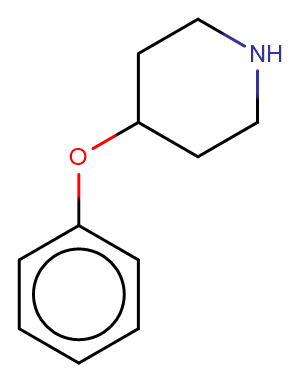
4-phenoxypiperidine
CAS No. 3202-33-3
4-phenoxypiperidine( —— )
Catalog No. M21097 CAS No. 3202-33-3
4-phenoxypiperidines with muscle relaxant and anticonvulsant activities.
Purity : >98% (HPLC)
 COA
COA
 Datasheet
Datasheet
 HNMR
HNMR
 HPLC
HPLC
 MSDS
MSDS
 Handing Instructions
Handing Instructions
| Size | Price / USD | Stock | Quantity |
| 5MG | 48 | Get Quote |


|
| 10MG | 68 | Get Quote |


|
| 25MG | 115 | Get Quote |


|
| 50MG | 173 | Get Quote |


|
| 100MG | 258 | Get Quote |


|
| 200MG | 388 | Get Quote |


|
| 500MG | 642 | Get Quote |


|
| 1G | Get Quote | Get Quote |


|
Biological Information
-
Product Name4-phenoxypiperidine
-
NoteResearch use only, not for human use.
-
Brief Description4-phenoxypiperidines with muscle relaxant and anticonvulsant activities.
-
Description4-phenoxypiperidines with muscle relaxant and anticonvulsant activities.
-
In Vitro——
-
In Vivo——
-
Synonyms——
-
PathwayOthers
-
TargetOther Targets
-
RecptorOthers
-
Research Area——
-
Indication——
Chemical Information
-
CAS Number3202-33-3
-
Formula Weight177.24
-
Molecular FormulaC11H15NO
-
Purity>98% (HPLC)
-
Solubility——
-
SMILESc1ccc(OC2CCNCC2)cc1
-
Chemical Name——
Shipping & Storage Information
-
Storage(-20℃)
-
ShippingWith Ice Pack
-
Stability≥ 2 years
Reference
1.Boswell R F Helsley G C Duncan R L et al. Synthesis of some N-carboxylic acid derivatives of 3-phenoxypyrrolidines 4-phenoxypiperidines and 3-phenoxynortropanes with muscle relaxant and anticonvulsant activities[J]. Journal of Medicinal Chemistry 1974 17(9):1000-1008.
molnova catalog



related products
-
Resorufin sodium sal...
Resorufin sodium salt is a fluorescent pink dye.
-
Diosmin Impurity 5
Diosmin analog. Reference standards.
-
HIV Integrase Protei...
His-Cys-Lys-Phe-Trp-Trp is an inhibitor for the human immunodeficiency virus (HIV) integrase with an IC50 of 2 μM.



 Cart
Cart
 sales@molnova.com
sales@molnova.com


